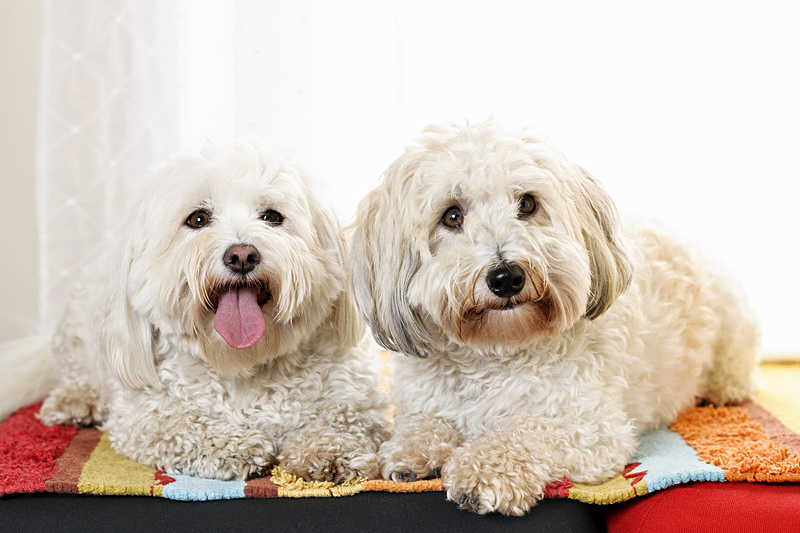The Coton de Tuléar is essentially a living cotton ball, as the first part of its name (French for “cotton”) suggests. The second part of its name stems from a port town in Madagascar, the island-nation of its origin, where this small and delightful snow-white lapdog was the go-to companion of the ruling class. In only a half-century or so, the Coton’s fame has spread well beyond that Indian Ocean homeland and it’s not at all hard to see why. From family households to therapy programs for special-needs individuals, these charismatic and merry dogs are pretty much impossible to dislike.

The Coton de Tuléar
History
The exact origins of the Coton de Tuléar are a bit shrouded and certainly intriguing: Kris Forke, writing for the American Coton Club, describes the breed’s history as “mysterious, intriguing, exotic, and romantic.” Various stories tell of their fancy ancestors swimming ashore in Madagascar from a shipwreck, brought to the island by traders or pirates, and breeding with locals dogs during a formative feral phase in back-country Madagascar’s scrub and tropical forest.
Wherever and however the ancestral Coton came about, its modern history saw it coveted by Madagascar’s Merina royalty and elites, who at one point passed laws forbidding common folk from owning these plush pups. French colonial bigwigs also took a shine to the breed. The Coton’s significance in the country is such that it’s appeared on postage swamps and is still commonly referred to as “the Royal Dog of Madagascar.”
The Coton de Tuléar was “discovered” by dog fanciers outside Madagascar in the 1960s and ’70s, when Cotons began to be imported and bred in significant numbers in France, the United States, and elsewhere. Further breeding in Europe fine-tuned the Coton’s features, making its coat all the plusher, for example. According to the American Coton Club, demand for the breed in the U.S. really took off in the 1990s and has continued apace. In 2014, the American Kennel Club (AKC) registered its first Cotons, a sign of their ever-increasing profile.
Appearance
Imagine a cotton ball with two black eyes and a black nose – oh, and a lolling pink tongue – and you’ve pretty much envisioned the Coton de Tuléar. That is, you’ve imagined the classic Coton de Tuléar: While most are indeed a snowy-white, other colors, including black, tan, and tricolored, are often seen.
These small dogs stand between 9 and 11 inches tall and weigh some 8 to 15 pounds. They’re squat and sturdy-looking with a subtle curve above the loin and a tail that, when its owner isn’t hyped-up, tends to hang low and close.
The Coton’s coat doesn’t only look like cotton: It feels like it as well, soft and plush.
Personality and temperament
The Coton de Tuléar has a truly winning temperament. It was, after all, bred exclusively to be a companion dog, and it excels at this sociable, playful, comforting role. Given its affectionate and even clownish nature – shuffling about on its hind legs is a common performance – it’s not really a surprise, as the American Coton Club notes, that it’s sometimes nicknamed the “anti-depressant breed.”
These lapdogs love spending time with their owners: That’s essentially their M.O. Whatever you’re doing, your Coton likely wants to be right alongside. If socialized as a puppy and encouraged in its natural inclination to make friends at every turn, the Royal Dog of Madagascar will happily greet friends and strangers alike on your daily walks. They’re attention-seeking and attention-loving, and pretty much guaranteed to put a smile on your (and everybody else’s) face.
Cotons de Tuléar are commonly employed as therapy dog, such is their sweet and infectious disposition. In short, the Coton essentially specializes in companionship; it follows that the dog doesn’t do well if left alone for long periods of time, so consider your own work schedule before committing to ownership.
Cotons are also alert and ready barkers, so they make decent watchdogs.
Shedding & grooming
The Coton’s luxurious coat requires quite a bit of gentle brushing and combing, although some owners opt for a shorter and lower-maintenance “puppy” cut. The AKC recommends checking your Coton’s ears a few times a week to clear any obstructions and look for any signs of infection.
This breed doesn’t shed much at all and is relatively hypoallergenic.
Health and lifespan
The Coton de Tuléar is quite a healthy and long-lived small dog, a typical life expectancy being on the order of 15 to 19 years.
Health issues are relatively few, but like many small dogs Cotons can be prone to luxating patella (basically a free-floating kneecap) as well as hip dysplasia and ear infections. The United States of America Coton de Tuléar Club defines as required testing for breeders a patellar and cardiac evaluation, dilated eye exams, and a radiograph on the dog’s hips, and also recommends elbow radiographs, a thyroid screening, and genetic testing.
Exercise needs
Cotons require moderate exercise: a generous, easy-paced daily walk, games of fetch, and the like. With proper training they’re wonderful dogs for agility trials.
Training and intelligence
Given their native intelligence and eager interactivity, Cotons de Tuléar are quite easy to train with positive reinforcement: They soak up praise, food rewards, and all-around attention. Again, socialization in early puppyhood prepares them for a lifetime of comfortable outgoingness and geniality.
